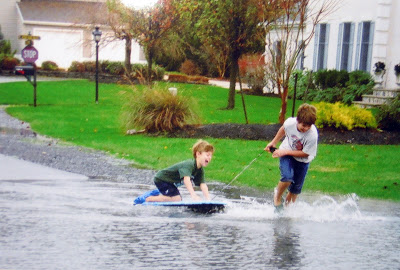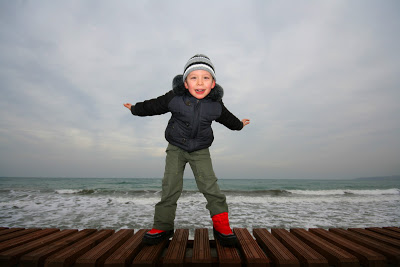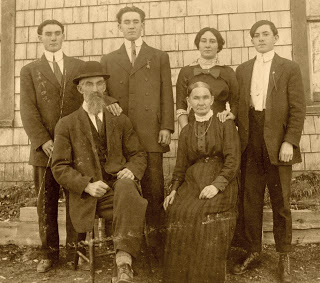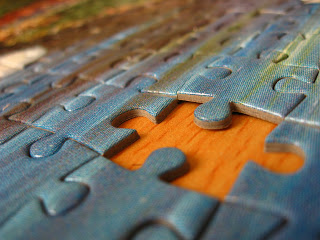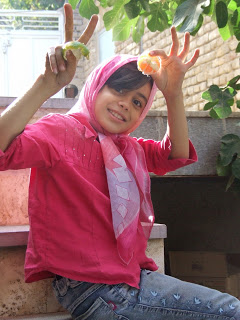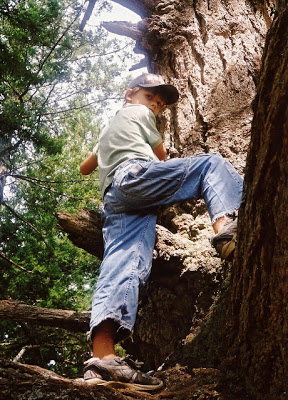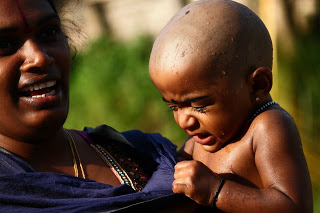(Like these real-life examples from our parenting and growing-up treasure trove: playing with matches under the bed, playing with firecrackers in the basement, starting or DRIVING the car before being able to see over the dashboard, parachuting off the garage roof with a plastic green garbage bag cape!)
Monthly Archives: March 2011
Does Size Really Matter? David and Goliath
The rest, as they say, is history. The stone from David’s sling hit mighty Goliath in the forehead, toppling the giant to the ground. Then, seizing the Philistine’s own sword, David cut off Goliath’s head.
Click here how to tell a story, such as the David and Goliath story
Courage Quote of the Day
Sharing Family Stories
Every summer, when we return home to the West Coast of Canada for a family fill-up, my kids beg their great uncles to tell the stories of their madcap youth. My kids love to hear the pranks they’ve played on each other, their childhood adventures during a time when kids played regularly together in their neighborhoods unsupervised until someone’s mother called you all home. My kids especially love tales of my uncles’ feats of daring during those less litigious times when the biggest threat was their dad’s belt hanging by the stairs to the basement.
They repeat my uncles’ stories, checking in with me to make sure they’ve remembered ALL the details—especially the funny bits. These stories are touchstones of family connection. Before they are done retelling the time my one uncle awoke bleary-eyed to the inside of a spitball-covered hotel room, rolling over to find his 13 year-old’s birthday cake smeared with hand prints and whole chunks missing, the floor covered in wet towels; my kids and I are crying with laughter. While my uncle had slept peacefully after hearing the polite goodnights from their adjoining room, my cousin and his pals had roamed the hotel where he hosted his 13th birthday party that year. Included was a midnight swim in the off-limits moat surrounding the main hotel concourse, covering both rooms with a splattering of spitballs (you couldn’t see the screen of the TV), and the requisite game of ‘Nicky-Nicky Nine-Doors’ to keep all their fellow guests guessing as to the ruckus through the night. Imagining my uncle marching out of the hotel, telling my cousin and his pals (through clenched teeth) to keep walking “heads down”—hoping to avoid the consternation of the hotel clerk and a huge hotel bill—evokes memories of our own most embarrassing moments when we’ve wished the floor would open up and swallow us whole.
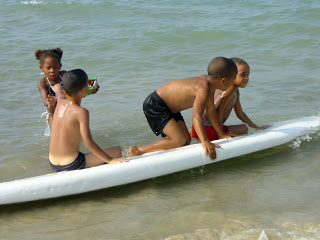 It is through the collective lenses of family stories that my children are able to glimpse the family they come from, to understand more about themselves, and imagine what they may be capable of achieving. One of our family members just need start with “Remember when…” and my kids are glued to the dinner table. No iPod, TV show, or YouTube sensation can capture their attention the same way a funny family story can.
It is through the collective lenses of family stories that my children are able to glimpse the family they come from, to understand more about themselves, and imagine what they may be capable of achieving. One of our family members just need start with “Remember when…” and my kids are glued to the dinner table. No iPod, TV show, or YouTube sensation can capture their attention the same way a funny family story can. A footnote: After living in Saratoga Springs, NY for almost four years I recently learned that my maternal ancestors were actually born in Saratoga. A distant relative filled in the blanks for me about that particular branch of my children’s family tree, put it into a book full of family stories and archive photos, and mailed it to us. It turns out that having the courage to travel, uproot your family, and follow employment to new lands may just bring you back to brave new beginnings, a little older but perhaps wiser!
Tell us one of your favorite family stories–we’d love to hear your voice, too!
Shout Out
We would like to say a special “Thank You” to a brave young mother and wonderful staff writer at the Times Union in Albany, NY for her great article today about Lion’s Whiskers. To read
“A Lesson in Courage”, click here!
Share this link, join our subscription list (it’s anonymous), become a follower, tweet us, “Like” us on facebook, and most of all share your parenting wisdom with us by posting your comments!
What is Spiritual Courage?
Compiled and written by Lisa and Jennifer:
This will be the sixth in the “Six Types of Courage” that we will explore in-depth. We hope you’ve already had the chance to read over our page called “The Six Types of Courage” for a brief overview of our definitions. The examples we give for each type of courage may apply to your children and/or to you —please keep in mind, when you are reading this post, that some of these examples may involve taking “baby steps” on your way to spiritual courage! Every step towards courage is both worthwhile and important.
Spiritual Courage
“This is my simple religion. There is no need for temples; no need for complicated philosophy. Our own brain, our own heart is our temple; the philosophy is kindness.”— His Holiness the Dalai Lama
“Here is a test to find whether your purpose in life is finished: if you are alive, it isn’t.”— Richard Bach
For inspiring true stories, ways to recognize and coach spiritual courage in ourselves and our children…READ ON!
Spiritual courage allows us to encounter people of different religious faiths and spiritual traditions without judgment. Remember the photos from the Egyptian revolution earlier this year, when Christians made a protective cordon around Muslims during prayer? That looks like spiritual courage to us.
- attending religious festivals and listening to stories from faith traditions other than your own
- talking with children openly and honestly about death
- having friendships with people from faith traditions other than your own
- for parents, making sure you have written a will, arranged legal guardianship for your children in the event of your death, as well as writing advance directives for medical emergencies
- giving your children the option to pursue a religious practice or attend a youth group, even if you don’t attend or practice regularly
- making time to pray, meditate, or do charitable work
- holding a funeral for a pet
- letting go of the need to control everything in life
- reaching out in times of need and asking for help—discovering that there are, in fact, lots of resources in your community
- building meaningful rituals into your daily life, such as quiet contemplation with a cup of tea, or a walk in the woods with your kids
Lack of spiritual courage looks like:
- making judgments based on the religious identification of others
- refusing to try attending a religious service even when your child invites you or expresses interest in religion
- refusing to attend someone’s wedding, funeral or other rite of passage because of religious intolerance
- unwilling to question your strongly-held beliefs
- unwilling to plan for your own death
- not respecting the wishes of a loved one who is faced with a life-threatening diagnosis
- unwilling to accept that spirituality can exist outside the walls of a religious institution
- unwilling to make a values inventory
- not walking the talk
- lack of respect for others, their beliefs, their culture, and the environment
Spiritual courage sounds like:
- “May I go to your church/temple/mosque with you some time?”
- “What do you believe?”
- “That’s not a belief I’m familiar with. Can you tell me more about that?”
- “I have questions.”
- “I want to make a difference with my life.”
- “What happens to us after we die, Mommy?”
- “Can I say grace tonight, Dad?”
- “I’m grateful for ___________.”
- “Before I die, I want to __________.”
- “Let’s talk about who we’d like to raise our kids if we die whilst they are still young.”
Lack of spiritual courage sounds like:
- “What difference does it make anyway?”
- “They are evil.”
- “Don’t think about such morbid things!”
- “All religions breed fanatics!!”
- “Religion in the opiate of the masses.”
- “You really believe that stuff?”
- “Sounds like some kind of a cult!”
- “I can’t talk to you about that because you’re not a member of my church/mosque/synagogue.”
- “I did it in the name of ___________”
- “I give up.”
Grab Some Lion’s Whiskers!
Here are some tips for developing spiritual courage for you and your kids
- read stories from all world religions and encourage your children to ask questions and find similarities from one culture to another
- read at least a bit of the Koran, the Bible, Talmudic teachings, Buddhist teachings, etc.
- if you’ve never been to a Passover seder, ask a Jewish friend to include you next time; if you’ve never been to a baptism, ask a Christian friend to include you; by connecting respectfully with friends from faiths other than your own, you encourage them and yourself
- ask the important questions before it’s too late!
- surround yourself and your children with beauty
- take a walk in nature; wake up early enough to catch a sunrise; on a night walk, stop and simply stare at the stars; take a deep breath in the open air
- hang famous and not so famous artwork—especially your children’s, and not just on the fridge
- play Classical as well as Top 40 music
- stop and smell the flowers
- try a yoga class—even see if there is one for kids in your community
- investigate “alternative” spiritual practices such as meditation or sweat lodge with an open mind
- work in the garden together, it’s a wonderful way to experience the circle of life
Posts related to spiritual courage: Courage as an Antidote to Fear, Getting to the Heart of Courage,
The Flyaway Lake
What are your ideas about spiritual courage, your parenting tips to promote it with kids, or your favorite spiritual courage story (fiction or non-fiction)? We’d love to hear from you!
Guest Post Today on www.yourwildchild.com
I’ve written a guest post for a wonderful blog written by Melynda Coble Harrison, to inspire parents to get outside with their kids and discover the natural world. Here’s the link to read my post about coaching physical courage in our kids and climbing trees!
Telling Our Stories
Long before I wrote stories, I listened for stories. Listening for them is something more acute than listening to them. I suppose it’s an early form of participation in what goes on. Listening children know stories are there. When their elders sit and begin, children are just waiting and hoping for one to come out, like a mouse from its hole. — Eudora Welty, American author
Have you ever noticed how eager our children are to hear stories of our own childhood? It seems as if they yearn to know us as we were, before they existed. We are their “in the beginning,” their creation myths, even when (as in adoptive or blended families) we didn’t actually create them. They see us as adults, they see us as people who successfully got from there (childhood) to here (adulthood) and they are curious how it happened. What is the story of how I became grown? The Anne Sexton poem Lisa shared a few posts back reminds me of this – those moments of courage from our past are our story, the record of our hero journey.
 |
| c. Yanni Raftakis, Dreamstime.com |
In our house, the stories I most often tell of my own childhood and teen years have to do with “most embarrassing moments.” These are the stories that required social courage. In an era where physical courage is called upon less and social courage called upon more often, these are the hero tales I find myself telling. That they more often feature me failing in social courage makes them no less compelling for K. I try to inject these tales with as much comedy as possible, and make myself as much a figure of fun as possible, because how else to show that you can survive an embarrassment? Here I sit, alive and unscarred. Somehow I survived the infamous wetting-my-pants-in-the-snow story (there was steam), the blushful yesterday’s-underpants-creeping-out-from-the-cuff-of-my-jeans-at-school story, the cringe-worthy smelly-feet-during-play-rehearsal story. These and many others are requested again and again like sentimental ballads on an all-request radio station. I am commanded to tell these stories not just to my daughter, but to audiences of her friends as if they were edge-of –the-seat war stories of near misses on the front lines. The fact is that’s what they are. I think any parent could search their past for their most embarrassing stories and tell them with relish – slather them with juicy detail and groaning laments. Their cheerful willingness to share them is proof enough that the battle can be won and the hero can survive to tell the tale. “Some day, my child, you shall have a hearty laugh over this,” may be a difficult pill to swallow in the moment, but the stories will be reassuring evidence that it is true.
Why Attachment is so Important in Learning Courage
As a mom to newborn E. (my now 13 year-old son), I was ripe with the maternal love hormones prolactin and oxytocin. It’s one of the reasons new parents seem a bit dopey. Biochemicals like oxytocin, prolactin, and vasopressin, in particular, make maternal and paternal bonding possible. We are all, it turns out, wired for connection. In those early days with E. it didn’t really matter to me that there were specific centers of my brain, and highly elaborate neural mechanisms activated to ensure my maternal love, recognition of my baby, and the kind of protectiveness that promotes secure attachment. I was either blissfully oblivious or too darn tired to notice. Read on for some “good news!”
 |
| Copyright Andrey Kiselev, Dreamstime.com |
I now know that not only was it important that I received loving care and touch myself as an infant—particularly in the first six months of life—but having a secure attachment with my husband also helped immensely in coaxing him into the intense dyad that E. and I became. Those extended invitations for my husband to co-parent with me not only, it turns out, helped to ensure E.’s survival through their secure attachment—but has also proved to be an essential primary attachment and positive model of manhood for E. We had both already established our ability to receive and give love, and here in our arms was the perfect opportunity to put it all into practice.
Also, while reading this post I’d like you to reassure you! I’d like you to think of attachment as a spectrum, on one end is the abandoned orphan who never had the chance to form a secure attachment with a loving, consistent caregiver. We all sadly learned about these orphans in news footage during the early 1990’s when Ceauşescu’s regime collapsed in Romania. Many of these orphans were later adopted into brave families throughout the world and have gone on to thrive because of their adoptive parents’ consistent, loving care. The orphans who were never held, barely fed, and exposed to a multitude of infectious diseases in their first six months rarely recovered a capacity to thrive developmentally, intellectually, and even more importantly for survival, interpersonally. In some cases, the neurological damage was permanent. That’s how extreme the depravity needs to be for a human being to cease learning to form secure attachments.
On the other end of the spectrum, nestled comfortably behind the proverbial picket fence, is the mother-father-infant triad with plenty of love, time, financial resources, community support, and health insurance—as if there is one perfect way to secure attachment learning in a child. Which there isn’t! Between these two extremes, we all find ourselves cobbling together our resources, knowledge, genetics and inborn temperament, family configuration, circumstances of our lives, and personal histories, spinning the wheel of life, and landing where we may on the spectrum with our child. It’s all just about learning how and continuing to form loving connections, which often takes emotional courage! We will be discussing throughout upcoming posts ways to promote and ensure parent-child secure attachment and sharing some inspiring examples from around the world!
Let’s be clear: Across the spectrum of attachment the vast majority of us continue to prove our remarkable resilience and neuroplasticity! Neuroplasticity meaning: the brain’s natural ability to form new connections in order to compensate for injury or changes in one’s environment.
- self-calming skills
- being aware of one’s own emotions
- recognizing the feelings of others
- being compassionate
- impulse control
- ability to make eye contact
- sharing and turn-taking
When we ensure secure attachment between ourselves and our children through loving them, we do not spawn cling-ons. Being a secure attachment relationship for your child also doesn’t mean you need to be at home full-time, never let them out of your sight, or never lose your patience. It looks more like trusting your gut, loving your child, and doing your level best as a parent whatever the circumstances of your life. There are specific steps to forming secure attachments with children which I will be writing at-length about in this parenting blog.
As a parenting coach, I have the unique opportunity to help parents ensure that they are engaging in the kinds of behaviors, stimulating the kinds of neurochemicals necessary, and thinking the kinds of thoughts that trigger the hormonal chain reactions involved in forming secure attachments. More about the chemical soup we call love in my upcoming posts! If you have questions about attachment and/or an interest in parent-coaching, don’t hesitate to post a comment or contact me.
Share your tales of courage from parenthood! We want to hear from you!
Sources:
Beckett, C., Maughan, B., Rutter, M., Castle, J., Colvert, E., Groothues, C., Kreppner, J., & Stevens, S.,
O’Connor, T., Sonuga-Barke, E. (2006). Do the effects of early severe deprivation on cognition
persist into early adolescence? Findings from the English and Romanian adoptees study. Child
Development, 77, (3), 696 – 711.
Follow us on Twitter
Yes, just what you’ve been waiting for, you can now follow us on Twitter@ LionsWhiskers. See you there!
